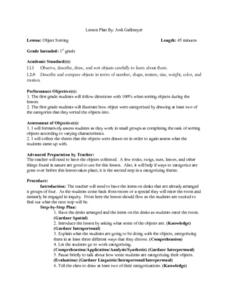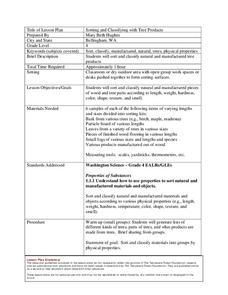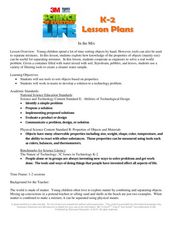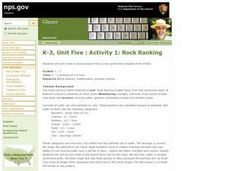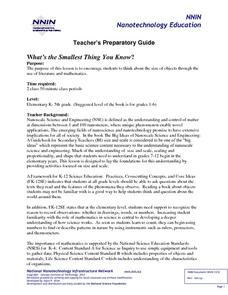DiscoverE
Sorting Solutions
It's okay to play with your food—just this once! Scholars design and create meshes and chutes to sort pasta by size and shape. They test their designs and make improvements as necessary.
Education Outside
Seed Sort
"One of these things is not like the other. . ." After listening to a story about seeds and discussing the role of seeds, kindergartners sort five different seeds by size, shape, and color.
Curated OER
Sorting Things Out
Written to examine seeds that grow in Kansas, you can adapt this lesson plan to anywhere you live. Learners sort a mixture of five different seeds to by any characteristic of their choice. When your budding scientists are exploring the...
Curated OER
Object Sorting
First graders follow directions when sorting objects. They illustrate how objects are categorized by drawing at least two of the categories that they sorted the objects into. Students work in small groups at completing the task of...
Curated OER
Nature Art
In this nature art lesson, students take a nature walk and collect items with different sizes, textures and colors. Students use the items they collect to make a collage.
Curated OER
Gummy Bear Sorting
Students demonstrate knowledge of sorting and classifying by color as they sort gummy bear candies.
Curated OER
An Introduction to Acids and Bases
Students explore acids and bases. In this lesson about acids and bases, students do an experiment to test certain items to determine what they are. Students use cabbage and litmus paper as indicators. Students understand how to sort the...
Curated OER
Fun Activities Using Seeds
Learners analyze the size, shape, and form of several different seeds. In this all about seeds lesson plan, students complete four activities involving characteristics of seeds. Learners observe the seeds, record information about the...
Curated OER
Sorting and Classifying with Tree Products
Fourth graders sort and classify wood. In this sorting tree products lesson, 4th graders sort and classify tree parts and pieces of wood, both natural and manufactured according to their properties.
Curated OER
Seed Sorting
Young scholars examine and sort seeds. For this life science lesson, students make general observations of a tub of seeds, then develop sorting criteria for sorting the deeds. Lesson includes extension activities.
Curated OER
What Is in a Rock?
Students identify, sort, and classify mineral samples that make up a common rock.
Center for Learning in Action
Properties of Balls
Enhance your states of matter lessons with a hands-on science investigation that compares six different balls' color, texture, size, weight, ability to bounce, and buoyancy.
Curated OER
Exploring Rocks
Students recognize differences in the size, shape, texture, and color of different rocks. For this rocks lesson plan, students also learn and repeat back how a volcano erupts and make one out of a toilet paper tube.
Curated OER
HOW FAST DO SEDIMENT GRAINS OF DIFFERENT SIZES SETTLE?
Students conduct an experiment using sand, a jar, and a paper clip to analyze the effects of different kinds of sand vis a vis its sediment. They graph their findings and analyze for factors of size, shape, and density.
Curated OER
How Does Flowing Water Shape a Planet's Surface?
Students investigate how flowing water influence landforms. In this earth science lesson, students observe water behavior as it flows from the stream table at various inclinations. They discuss whether water shaped Mars landforms or not.
Curated OER
Donut Sort
Third graders create dichotomous keys using donuts. In this dichotomous lesson, 3rd graders review what a property is and sort donuts by a specific property. Donuts are kept in plastic baggies for the activity so they can be enjoyed by...
Curated OER
Look At Those Leaves!
Learners observe and sort tree leaves. In this earth science lesson, students observe the attributes of real leaves and measure leaves using Unifix cubes.
Curated OER
In the Mix
Students construct a water filter. In this engineering lesson, students discover how to construct a water filtration system. Students work in groups to sort tools by their properties. Students analyze and construct a water filtration...
Curated OER
Hardware Sort
Students classify various hardware items using the attributes of the objects. In this classification lesson, students group objects based on their attributes and explain their classification key.
National Park Service
Rock Ranking
Junior geologists sort rocks and soil. They separate a sample of river gravel by size, shape, color, and other characteristics. To include Common Core standards, you could have little ones graph the number of particles in each sample.
Curated OER
Rocks and Minerals
Fifth graders examine different types of rocks and classify rocks by their different characteristics. In small groups they sort their rocks into two categories, then create three categories to sort by on a sorting worksheet. Next, they...
Curated OER
Making a Rock Collection, Lesson 1
Students discover the different shapes and sizes of rocks. They create a chart on what they already know about rocks and sort rocks by size. They place cutouts of rocks on construction paper from smallest to largest.
Curated OER
Seeds in Fall...Collect Them All!
Classify seeds by attributes such as size, shape and color! Learners classify seeds using a dichotomous key. They identify human behaviors that have a positive impact on preserving seed and plant biodiversity.
National Nanotechnology Infrastructure Network
What’s the Smallest Thing You Know?
Elementary learners listen to a story, then sort objects from largest to smallest at six different stations around the classroom. Adaptable for a large range of age and ability groups.



